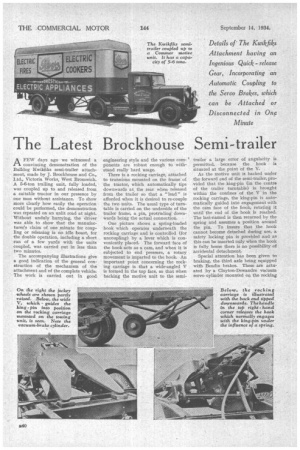The Latest Brockhouse Semi-trailer
Page 50

Page 51

If you've noticed an error in this article please click here to report it so we can fix it.
AFEW days ago we witnessed a convincing demonstration of the Bulldog Kwikfiks semi-trailer attachment, made by J. Prockhouse and Co., Ltd., Victoria Works, West Bromwich. A 5-6-ton trailing unit, fully loaded, was coupled up to and released from a suitable tractor in our presence by one man without assistance.. To show more clearly how easily the operation could be performed, the demonstration was repeated on an unlit road at night. Without unduly hurrying, the driver was able to show that the manufacturer's claim of one minute for coupling or releasing is no idle boast, for the double operation, including a short run of a few yards with the units coupled, was carried out in less than two minutes.
The accompanying illustrations give a good indication of the general construction of the mechanism of the attachment and of the complete vehicle. The work is carried out in good
engineering style and the various components are robtst enough to withstand really hard usage.
There is a rocking carriage, attached to trunnions mounted on the frame of the tractor, which automatically tips downwards at the rear when released from the trailer so that a "lead " is afforded when it is desired to re-couple the two units. The usual type of turntable is carried on the underside of the trailer frame, a pin, protruding downwards being the actual connection.
One picture shows a spring-loaded hook which operates underneath the rocking carriage and is controlled (for uncoupling) by a lever which is conveniently placed. The forward face of the hook acts as a cam, and when it is subjected to end pressure, a rotary movement is imparted to the hook. An important point concerning the rocking carriage is that a wide-angled V is formed in the top face, so that when backing the motive unit to the semi
trailer a large error of angularity is permitted, because the hook is situated at the point of the V.
As the motive unit is backed under the forward end of the semi-trailer, provided that the king-pin (in the centre of the trailer turntable) is brought within the confines of the V in the rocking carriage, the king-pin is automatically guided into engagement with the cam face of the hook, rotating it until the end of. the hook is reached. The last-named is then returned. by the spring and assumes a position around the pin. To insure that the hook cannot become detached during use, a safety locking pin is 'provided and as this can be inserted only when the hook is fully home ;there is no possibility of accidental detachment.
Special attention has been given to braking, • the third axle being equipped with Bendix brakes. These are actuated by a • Clayton-Dewandre vacuum servo cylinder mounted on the rocking carriage (on the motive unit), with the operating mechanism so timed that they are applied slightly in advance of the brakes on the other wheels. The mechanism is simple, a secondary pedal being mounted on the face of the normal pedal so that a control valve is opened immediately the driver applies pressure.
An important feature is that the connection for the brakes between the two units is automatically released and connected when the tractor is driven away from, or backed up to, the trailer. This is accomplished by employing a swinging lever on the rocking carriage. *hen the units are coupled, this lever engages with a plunger, which applies the shoes to the drums.
There is, of course, a bogie attached to the forward part of the trailing unit, in order that the front end may be selfsupporting ; the bogie itself is raised and lowered by means of a -crank handle, fitted to a cross-shaft. The winding position is in close proximity to the hand lever for the trailing-wheel brakes, so that it is unnecessary for the driver to walk around the vehicle in order to operate the various controls.
To disconnect the units is even simpler than to couple them up. The safety locking pin is removed from the control handle operating the hook, the bogie wheels are then lowered to the ground, the tail-light attachment is disconnected and after it has been verified that the parking brake is applied the motive unit is ready to be driven clear. This can be done so soon as the release lever has been pulled to one side to disengage the hook from the king-pin.
The Kwikfiks rocking carriage, including the vacuum servo brake arrangement with automatic coupling, costs whilst a complete chassis built to carry a body measuring 18 ft. by 6 ft. -6 ins. is priced at £147. '




















































































